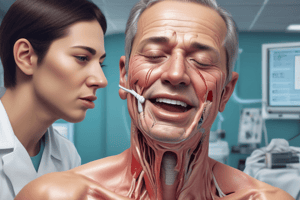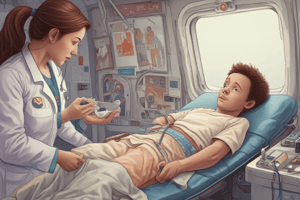Podcast
Questions and Answers
What is a common sign of mild foreign body obstruction in infants?
What is a common sign of mild foreign body obstruction in infants?
- Cyanosis
- Loss of consciousness
- Decreased work of breathing
- Stridor (correct)
What should be the first action taken if an unresponsive infant is found to have a foreign body obstruction?
What should be the first action taken if an unresponsive infant is found to have a foreign body obstruction?
- Look inside the mouth for the object (correct)
- Begin CPR immediately
- Attempt to ventilate
- Initiate the Heimlich maneuver
Which of the following is NOT a characteristic of severe foreign body obstruction in infants?
Which of the following is NOT a characteristic of severe foreign body obstruction in infants?
- Unconsciousness
- Good color (correct)
- Increased work of breathing
- Cyanotic appearance
What should be done if a responsive child is experiencing a foreign body aspiration?
What should be done if a responsive child is experiencing a foreign body aspiration?
What should be performed after assessing pulse and attempting ventilation on an unresponsive infant with a foreign body obstruction?
What should be performed after assessing pulse and attempting ventilation on an unresponsive infant with a foreign body obstruction?
What characterizes respiratory distress in pediatric emergencies?
What characterizes respiratory distress in pediatric emergencies?
What is the primary difference between respiratory failure and arrest?
What is the primary difference between respiratory failure and arrest?
Which of the following indicates a critical state where early intervention is crucial?
Which of the following indicates a critical state where early intervention is crucial?
What is a sign that may indicate the severity of a patient's respiratory condition?
What is a sign that may indicate the severity of a patient's respiratory condition?
Which condition progresses from respiratory distress if fatigue sets in?
Which condition progresses from respiratory distress if fatigue sets in?
When managing airway and breathing in pediatric emergencies, what should be assessed to gauge severity?
When managing airway and breathing in pediatric emergencies, what should be assessed to gauge severity?
What is one of the main factors to identify before succeeding in airway management?
What is one of the main factors to identify before succeeding in airway management?
What is the primary objective of reassessing the patient frequently during pediatric respiratory emergencies?
What is the primary objective of reassessing the patient frequently during pediatric respiratory emergencies?
What is a key component of asthma that contributes to respiratory issues?
What is a key component of asthma that contributes to respiratory issues?
Which of the following is the primary treatment for pneumonia?
Which of the following is the primary treatment for pneumonia?
What is a common trigger for asthma that could lead to an exacerbation?
What is a common trigger for asthma that could lead to an exacerbation?
Which medication may be given to a patient experiencing moderate to severe respiratory distress due to asthma?
Which medication may be given to a patient experiencing moderate to severe respiratory distress due to asthma?
What position is recommended for a patient experiencing respiratory distress from asthma?
What position is recommended for a patient experiencing respiratory distress from asthma?
Which clinical sign is commonly associated with asthma?
Which clinical sign is commonly associated with asthma?
Inhaled salbutamol is used primarily for which purpose in asthma management?
Inhaled salbutamol is used primarily for which purpose in asthma management?
What symptom is usually more likely in pneumonia compared to asthma?
What symptom is usually more likely in pneumonia compared to asthma?
What is the primary purpose of using an OPA?
What is the primary purpose of using an OPA?
In which scenario is a non-rebreathing mask preferred?
In which scenario is a non-rebreathing mask preferred?
When should the blow-by technique be used for oxygenation?
When should the blow-by technique be used for oxygenation?
What is the first step in addressing foreign body aspiration in children?
What is the first step in addressing foreign body aspiration in children?
What is a common sign of croup in a pediatric patient?
What is a common sign of croup in a pediatric patient?
What is a contraindication for using an OPA in a patient?
What is a contraindication for using an OPA in a patient?
What should be the rate of breaths delivered using bag-mask ventilation for infants?
What should be the rate of breaths delivered using bag-mask ventilation for infants?
Which management strategy is recommended for a child with severe croup?
Which management strategy is recommended for a child with severe croup?
Which method is generally not appropriate for children under 1 year?
Which method is generally not appropriate for children under 1 year?
Which of the following symptoms is NOT typically associated with epiglottitis?
Which of the following symptoms is NOT typically associated with epiglottitis?
How does the appearance of a child with croup typically present?
How does the appearance of a child with croup typically present?
What might indicate the need for a variety of mask sizes during bag-mask ventilation?
What might indicate the need for a variety of mask sizes during bag-mask ventilation?
All pediatric patients with respiratory emergencies should receive:
All pediatric patients with respiratory emergencies should receive:
What is a primary concern when assessing a child suspected of having epiglottitis?
What is a primary concern when assessing a child suspected of having epiglottitis?
What should NOT be done when managing a child with croup?
What should NOT be done when managing a child with croup?
Which description best fits epiglottitis?
Which description best fits epiglottitis?
What is the primary initial treatment for anaphylaxis?
What is the primary initial treatment for anaphylaxis?
Which of the following symptoms indicates severe anaphylaxis?
Which of the following symptoms indicates severe anaphylaxis?
What characteristic findings are associated with bronchiolitis?
What characteristic findings are associated with bronchiolitis?
What should be administered for respiratory distress in anaphylaxis?
What should be administered for respiratory distress in anaphylaxis?
Which medication is used in treating severe allergies or anaphylaxis?
Which medication is used in treating severe allergies or anaphylaxis?
What is the main management approach for bronchiolitis?
What is the main management approach for bronchiolitis?
Which of the following is NOT a symptom of anaphylaxis?
Which of the following is NOT a symptom of anaphylaxis?
What condition is primarily characterized by inflammation of small airways due to viral infection?
What condition is primarily characterized by inflammation of small airways due to viral infection?
What is a common trigger for anaphylaxis?
What is a common trigger for anaphylaxis?
What role does nebulized epinephrine play in pediatric respiratory emergencies?
What role does nebulized epinephrine play in pediatric respiratory emergencies?
Flashcards
Respiratory Distress
Respiratory Distress
Increased work of breathing, but adequate gas exchange
Respiratory Failure
Respiratory Failure
Patient cannot compensate; hypoxia or CO2 buildup.
Respiratory Arrest
Respiratory Arrest
Patient stops breathing.
Respiratory Distress vs. Failure
Respiratory Distress vs. Failure
Signup and view all the flashcards
Assessing Respiratory Distress
Assessing Respiratory Distress
Signup and view all the flashcards
Initial Evaluation
Initial Evaluation
Signup and view all the flashcards
Work of Breathing
Work of Breathing
Signup and view all the flashcards
Respiratory Emergency Treatment
Respiratory Emergency Treatment
Signup and view all the flashcards
Foreign Body Aspiration Risk
Foreign Body Aspiration Risk
Signup and view all the flashcards
Mild Foreign Body Obstruction
Mild Foreign Body Obstruction
Signup and view all the flashcards
Severe Foreign Body Obstruction
Severe Foreign Body Obstruction
Signup and view all the flashcards
Foreign Body Removal in a Responsive Infant
Foreign Body Removal in a Responsive Infant
Signup and view all the flashcards
Foreign Body Removal in an Unresponsive Infant
Foreign Body Removal in an Unresponsive Infant
Signup and view all the flashcards
Croup
Croup
Signup and view all the flashcards
Epiglottitis
Epiglottitis
Signup and view all the flashcards
Croup Management
Croup Management
Signup and view all the flashcards
Foreign Body Aspiration - Mild
Foreign Body Aspiration - Mild
Signup and view all the flashcards
Foreign Body Aspiration - Severe
Foreign Body Aspiration - Severe
Signup and view all the flashcards
Foreign Body Removal - Responsive Infant
Foreign Body Removal - Responsive Infant
Signup and view all the flashcards
Foreign Body Removal - Unresponsive Infant
Foreign Body Removal - Unresponsive Infant
Signup and view all the flashcards
Foreign Body Aspiration - Advanced Paramedics
Foreign Body Aspiration - Advanced Paramedics
Signup and view all the flashcards
Position of Comfort
Position of Comfort
Signup and view all the flashcards
Supplemental Oxygen
Supplemental Oxygen
Signup and view all the flashcards
Humidified Oxygen
Humidified Oxygen
Signup and view all the flashcards
What is Inhaled Salbutamol Used For?
What is Inhaled Salbutamol Used For?
Signup and view all the flashcards
Asthma Triggers
Asthma Triggers
Signup and view all the flashcards
Asthma Clinical Signs
Asthma Clinical Signs
Signup and view all the flashcards
Asthma Management
Asthma Management
Signup and view all the flashcards
Pneumonia Signs
Pneumonia Signs
Signup and view all the flashcards
Anaphylaxis Trigger
Anaphylaxis Trigger
Signup and view all the flashcards
Anaphylaxis Symptoms
Anaphylaxis Symptoms
Signup and view all the flashcards
Anaphylaxis Severity
Anaphylaxis Severity
Signup and view all the flashcards
Anaphylaxis Treatment
Anaphylaxis Treatment
Signup and view all the flashcards
Epinephrine for Anaphylaxis
Epinephrine for Anaphylaxis
Signup and view all the flashcards
Bronchiolitis Cause
Bronchiolitis Cause
Signup and view all the flashcards
Bronchiolitis Symptoms
Bronchiolitis Symptoms
Signup and view all the flashcards
Bronchiolitis Management
Bronchiolitis Management
Signup and view all the flashcards
Asthma Definition
Asthma Definition
Signup and view all the flashcards
Pneumonia Definition
Pneumonia Definition
Signup and view all the flashcards
OPA
OPA
Signup and view all the flashcards
NPA
NPA
Signup and view all the flashcards
Why are OPAs not recommended for children under 1 year?
Why are OPAs not recommended for children under 1 year?
Signup and view all the flashcards
When is blow-by oxygen used?
When is blow-by oxygen used?
Signup and view all the flashcards
When is a non-rebreathing mask used?
When is a non-rebreathing mask used?
Signup and view all the flashcards
What is bag-mask ventilation?
What is bag-mask ventilation?
Signup and view all the flashcards
What is the proper rate for bag-mask ventilation in infants and children?
What is the proper rate for bag-mask ventilation in infants and children?
Signup and view all the flashcards
What should we avoid when using OPAs?
What should we avoid when using OPAs?
Signup and view all the flashcards
Study Notes
Pediatric Respiratory Emergencies
- Course: HEM - 2123
- Instructor: Harmiya Hakkim
- Date: November 25, 2024
Section Overview
- Respiratory Distress
- Respiratory Failure
- Upper Airway Problems
- Lower Airway Problems
- Airway and Breathing Management
- Basic airway management
- Advanced airway management
Respiratory Emergencies
- Respiratory failure and arrest frequently precede cardiac arrests
- Early identification and intervention are crucial
Respiratory Distress & Failure
- Respiratory Distress: Increased work of breathing, adequate gas exchange
- Respiratory Failure: Patient can no longer compensate; hypoxia and/or carbon dioxide retention occur
- Respiratory Arrest: Patient stops breathing
Respiratory Distress & Failure (Assessment)
- Use PAT (Pulse, Appearance, and Tone) to determine severity before touching the patient
- Assess patient's work of breathing by:
- Noting patient's position of comfort
- Observing presence or absence of retractions
- Identifying signs of grunting or flaring
Respiratory Distress & Failure (Key Questions)
- Determine if patient has respiratory distress, failure, or arrest
- Respiratory distress requires generic treatment
- With fatigue, distress progresses to failure
- Reassess frequently
Upper Airway Problems
- Foreign body aspiration (FBAO) and choking
- Croup
- Epiglottitis
- Anaphylaxis
Foreign Body Aspiration/Obstruction
-
Infants and toddlers at high risk
-
Mild obstruction: Awake, stridor, increased work of breathing, good color
-
Severe obstruction: Cyanosis, unconscious
-
Responsive infants (FBAO/Obstruction): Deliver 5 back slaps, 5 chest thrusts
-
Unresponsive infants (FBAO/Obstruction):
- Look inside the mouth; remove object if visible
- If not, begin CPR (even if pulse is present)
- 30 compressions
- Look inside the mouth first
- Attempt to ventilate
- Assess for a pulse
- Repeat
-
Children: Heimlich maneuver
- If unresponsive:
- Look inside mouth – remove object if visible; if not, begin CPR
- 30 compressions
- Look inside the mouth first
- Attempt to ventilate
- Assess for pulse
- Repeat
- If unresponsive:
Croup
- Viral infection of the upper airway
- Patients typically alert
- Clinical signs: Audible stridor, barky cough, some increased work of breathing, normal skin color
Croup (Initial Management)
- Position of comfort
- Avoid agitating the child
- Nebulize with normal 0.9% saline (IV fluid)
- If severe, call an Advanced Paramedic
- Nebulize with Epinephrine
Epiglottitis
- Inflammation of the supraglottic structures
- Classic presentation: Sick, anxious, Drooling, Increased work of breathing, Pallor or cyanosis
- Symptoms progress rapidly
- Ask about immunizations, and get the child to an appropriate hospital
- Be prepared with a bag-mask device
- Call advanced paramedic
- Nebulized Epinephrine
- Humidified oxygen
Anaphylaxis
- Potentially life-threatening allergic reaction
- Triggered by exposure to an antigen
- Typically affects children older than 2 years
- Onset of symptoms occurs immediately
- Hives
- Respiratory distress
- Circulatory compromise
- Gastrointestinal symptoms
- Severe anaphylaxis: Child may be unresponsive, primary assessment may reveal
- Hives
- Swelling of lips/oral mucosa
- Stridor/wheezing
- Diminished pulses
Anaphylaxis (Treatment)
- Epinephrine
- Supplemental oxygen
- Fluid resuscitation for shock
- Antihistamine medications
- Bronchodilator medications
Anaphylaxis (Medications)
- Epinephrine (1:1,000): Severe allergy or anaphylaxis
- Adult/child over 8 years: 0.5 mg injection
- Child (6-8 years): 0.25 mg injection
- Child (6 months - 5 years): 0.125 mg injection
- Infant (less than 6 months): 0.05 mg injection
- Chlorpheniramine:
- Mild: 4 mg tablet
- Moderate: 10 mg injection
- Severe: 10 mg injection
Lower Airway Problems
- Bronchiolitis
- Asthma
- Pneumonia
Bronchiolitis
- Inflammation/swelling of small airways in the lower respiratory tract due to viral infection
- Highly contagious
- Characteristic findings: Mild to moderate retractions, Tachypnea, Diffuse wheezing, Mild hypoxia
Bronchiolitis (Management)
- Management entirely supportive
- Position of comfort
- Supplemental oxygen
- Humidified oxygen
- Inhaled salbutamol may be given for moderate to severe respiratory distress
Asthma
- Chronic disease
- Generally diagnosed only after 2 years of age
- Disease of the small airways
- Main Components: Bronchospasm, Mucus production, Airway inflammation, Results in hypoxia
- Triggers: Upper respiratory infections, Allergies, Exposure to cold, Changes in the weather, Secondhand smoke
- Clinical signs: Frequent cough, Wheezing, General signs of respiratory distress
Asthma (Symptoms)
- Coughing, Wheezing, Difficulty breathing, Fatigue
- Warning Signs: Headache, Stuffy/runny nose, Sore throat, Coughing/wheezing after exercise, Difficulty sleeping, Feeling moody/irritable, Tiredness/weakness during physical activity
Asthma (Management)
- Initial management: Position of comfort, Supplemental oxygen, Bronchodilators
- Salbutamol, Ipratropium Bromide
Pneumonia
- Disease infecting lower airway and lung
- Normally a bacterial infection
- Child will require antibiotics
- Signs: Unusually rapid breathing, Grunting/wheezing/crackles, Hypothermia/fever
- Primary treatment is supportive
Airway Management
- Look for obstructions
- Position airway
- Sniffing position
- Airway adjunct (OPA/NPA) may be helpful - OPA keeps tongue from blocking airway
- Rarely used for children under 1 year
- Avoid if facial trauma or moderate/severe head trauma
Airway Management (Oxygenation)
- All children with respiratory emergencies should receive supplemental oxygen.
- Common methods for pediatric patients:
- Blow-by technique
- Non-rebreathing mask
Airway Management (Bag-Mask Ventilation)
- Use if airway positioning/adjunct does not improve respiratory effort
- May need to try a variety of mask sizes
- Deliver breaths at a rate of 12 to 20 breaths/min for infants and children (depends on age)
- Ensure equipment is the right size
- Maintain a good seal with the face
- Ventilate at the appropriate rate and volume
- Do not hyperventilate
- Squeeze only until you see chest rise
- Two-person bag-mask ventilation is usually more effective
Advanced Airway Management (CPG)
- Assess for apnoea or special clinical considerations (e.g. GCS 3, SpO2 < 92%, RR ≤ 9, BVM ineffective).
- Minimum age for advanced airway is 2 years old.
- Consider FBAO.
- Proceed with supraglottic airway (maximum two attempts).
- If unsuccessful, revert to basic airway management.
- Ensure CO2 detection device in ventilation circuit and placement of advanced airway checked after each patient movement.
Studying That Suits You
Use AI to generate personalized quizzes and flashcards to suit your learning preferences.




